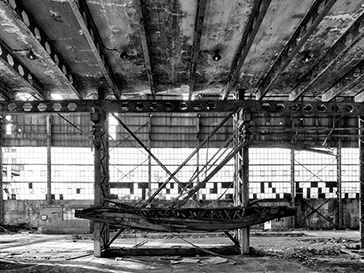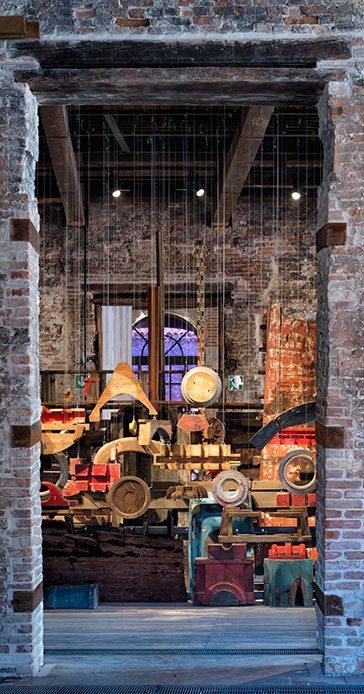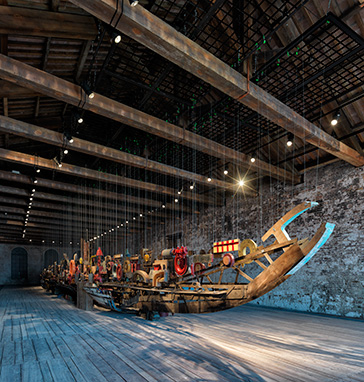Central to the concept behind Darzanà is the emphasis on frontier infringement and on hybridity. Challenging the increasing confinement within borders of religion, language, race, nationality, ethnicity and gender, the common cultural and architectural heritage shared between the arsenals of Istanbul and Venice is highlighted. For the Biennale Architettura 2016, a last vessel, a baştarda, has been constructed out of abandoned materials found in the old dockyard of Istanbul and transported to Venice to suggest a new connection in Mediterranean.

The project title Darzanà means dockyard and it is a hybrid word, like the Turkish word tersane and the Italian word arsenale. These words are derived or distorted from the same root, the Arabic daras-sinaa (place of industry). They all originate from the common language that developed in the Mediterranean from the 11th to the 19th century among people such as sailors, travellers, merchants, and warriors. Known as Lingua Franca, this was a shared language when Mediterranean was the main vessel connecting the surrounding cultures. In the same vein, it is possible to talk of a common architectural language and to define it as Architectura Franca.
Despite their very different identities and populations today, Venice and Istanbul once both featured considerable dockyards of similar sizes and production. The common core of these dockyards was the shipsheds called volti in Italian and göz in Turkish. The shipshed is the building block of a shared architectural heritage; its proportions grow out of the dimensions of boats and of common building technologies. It is like an archetypal womb, which gives birth to boats and lets them float out to other ports. Darzanà links a shipshed of İstanbul with a shipshed of Venice by a vessel. For the project Darzanà, a last vessel, a baştarda was built earlier this year at an abandoned shipshed at the Haliç dockyards in Istanbul.

Similar to Darzanà, baştarda is also a hybrid word. Derived from bastardo, a baştarda is a cross between a galley and a galleon and is propelled by oars and sails. As a symbol of Mediterranean hybridity, Baştarda of Darzanà creates a bridge between the two shipyards, one left to rot away in the megacity of Istanbul, the other springing to life only at certain times of the year in the museum-city that is Venice.

In Istanbul, Baştarda was constructed beneath a reproduction of the wooden trusses of the hall of Sale dArmi in the Venice shipyard that hosts the Pavilion of Turkey. Measuring 30 metres long and weighing four tons, the vessel was built from more than 500 pieces including seven kilometres of steel cable and abandoned materials found on site including wooden moulds, discarded furniture, signboards and boats. In April, the components were shipped to Sale dArmi, where Baştarda was re-constructed in May for the Pavilion of Turkey. When La Biennale closes in November 2016, Baştarda will continue her journey and she will eventually become the centrepiece of a museum of arsenal in Tersane, when the site is opened to public in Istanbul.
Darzanàs main theme raises the question of whether it is possible to transform borders, fronts and other spaces of conflict into thresholds and spaces of consensus. In this vein, Baştarda becomes a vessel of frontier infringement. She came to Venice, and she will eventually go back to İstanbul, travelling back and forth, just as the languages, the architectural forms, and people of the Mediterranean, have done throughout history. She will continue to tell her stories, and to show that one can trespass borders within cities or between cultures. Reporting from Darzanà, one can see the futility of demarcations on the seas and in between the words.
A book has been published to accompany the project Darzanà, which makes use of different archive materials to narrate the history of the dockyards in Haliç from their first creation through to their golden ages right up to recent times when they eventually became unusable. Edited by Feride Çiçekoğlu and featuring texts by Namık Erkal and Vera Costantini and photographs by Cemal Emden, the book will be available in two editions, English and Turkish, at the opening of the 15th International Architecture Exhibition of La Biennale di Venezia and will later be distributed by Yapı Kredi Publications in selected bookstores. The book and the exhibitions visual identity are designed by Bülent Erkmen.
The tote bag designed for the project by Hüner Aldemir features sail making details and is made out of repurposed sailcloth. The bags were produced in a limited edition and are numbered 1 through 500.
Darzanà: Two Arsenals One Vessel
Pavilion of Turkey at the
15th International Architecture Exhibition ,
La Biennale di Venezia
Curators: Feride Çiçekoğlu, Mehmet V. Kütükçüoğlu, Ertuğ Uçar
Curatorial Collaboration: Cemal Emden, Namık Erkal
Project Team: Caner Bilgin, Hande Ciğerli, Gökçen Erkılıç, Nazlı Tümerdem, Yiğit Yalgın
Baştarda
Design and Production Team Leader: Caner Bilgin
3D Modelling and Installation: Serdar Albaz, Yiğitalp Behram, Burak Sancakdar, Hüseyin Komşuoğlu
Tote Bag Design: Hüner Aldemir
Book and Communication Material Design: Bülent Erkmen
Video: Selçuk Metin
Lighting Design: ZKLD Studio
Lighting of the Arrtwork: Linea Light by TEPTA
Structural Consultant: Necati Çeltikçi
Webmaster: Sezen Özgür
Commissioner:
Istanbul Foundation for Culture and Arts (İKSV)
Selection Committee: Prof. Dr. Sibel Bozdoğan, Levent Çalıkoğlu, Prof. Dr. Arzu Erdem, Prof. Dr. Murat Güvenç, Yeşim Hatırlı, Prof. Dr. Suha Özkan, Prof. Dr. Uğur Tanyeli
Consutant: Deniz Ova
Project Manager: Tuna Ortaylı Kazıcı
Project Coordinator: Selen Erkal
Media Relations: Ayşe Bulutgil, Elif Obdan Gürkan, Özlem Bekiroğlu, Zeynep Seyhun, Özge Özgüleryüz, Arda Erdem Güneş, Poyraz Tütüncü
Corporate Identity and Publications: Didem Ermiş, Merve Evirgen, Selin Pervan, Erim Şerifoğlu
Marketing and Business Development: Tuba Tortop, Dilan Beyhan, Yıldız Lale Yıldırım, Lara Eram, Gülce Şahin, Sezer Kari, Bahar Helvacıoğlu, Özge Genç, Sedef Can
Sponsorship Programme: Yasemin Keretli Çavuşoğlu, Zeynep Pekgöz, Zeynep Karaman, Pelin Davidyan
Finance: Ahmet Buruk, Başak Sucu Yıldız, Kadir Altoprak, Deniz Yılmaz, Çiğdem Arslan
Public and International Grants: Aslı Yurdanur